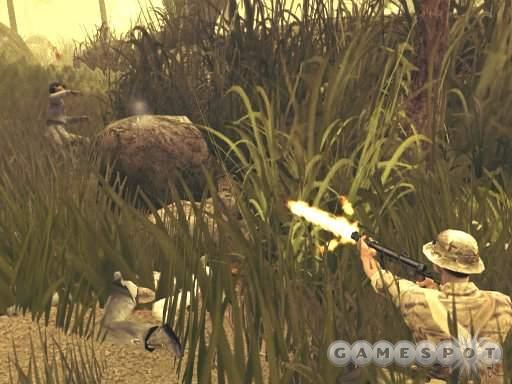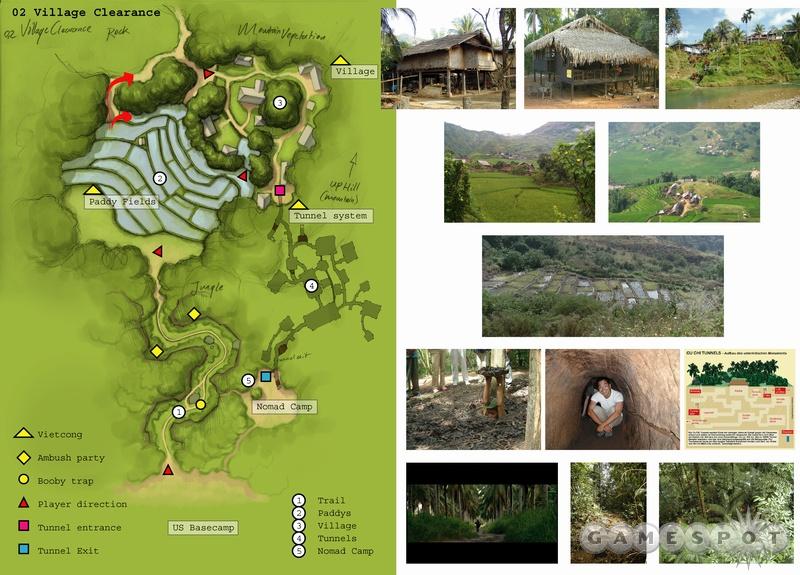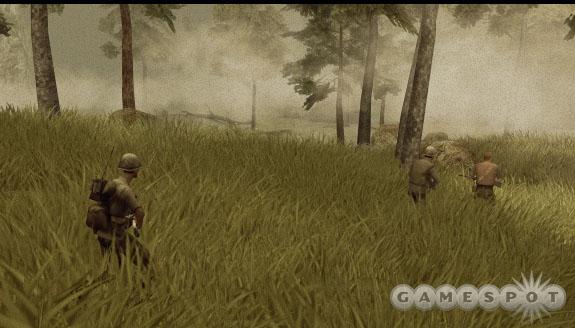ShellShock: Nam '67 Designer Diary 2
Lead artist Mathijs de Jonge talks about the process of re-creating Vietnam in game format.
Set for release in just two weeks, Guerilla's ShellShock: Nam '67 promises to be one of the grittiest video game versions yet of the Vietnam War. The game's graphic depiction of combat and its no-nonsense portrayal of American soldiers' lives during the war will play out against a backdrop of levels that have been meticulously crafted to mimic the real Vietnam as closely as possible. In our second designer diary for the game, development team lead artist Mathijs de Jonge tells us about the process of assembling the maps for the game.
Building Vietnamese Levels
By Mathijs de JongeLead Artist, Guerrilla Games
When we first started thinking about Shellshock: Nam '67, we decided that we wanted to make our game environment as atmospheric and close to reality as was humanly possible. We wanted the player to really believe that he or she was in Vietnam. In fact, we felt that in the past, jungles in games have looked quite generic, so we set out to make the most true-to-nature environments possible. So, how did we make our levels look like real Vietnamese landscapes?

Breakdown of Key Features
Vietnam is considered by many to be the most beautiful country on earth. Rich in terms of vegetation and animals, it is also host to the most incredible architectural remains, which mainly consist of ancient temples but also (more recently) include structural remnants left over from the French occupation of the country. You would expect that we couldn't go far-wrong with such variety and depth, but in reality, there was too much reference material available. As a result, our first task was to filter out the best locations for the game. We wanted environments that would fit into the level structure we had planned for the game--environments that players would instantly recognize and associate with Nam in 1967 but would also allow us to portray the horror of the conflict.
Initially, we used films to build up a long list of potential settings. We looked at jungles, paddies, temple ruins, French colonial districts, mountain villages, and a number of other locations. When we were satisfied with our shortlist, we then made sure that we had covered the horror-of-war angle. We used wastelands, napalmed tree lines, and bombed-out cityscapes to illustrate this. More importantly, we looked at how we could create a stifling, humid, hot, and sweaty "feel," or atmosphere, to the environments. This atmosphere is incredibly important, because it is part of the character of the country itself.
Reference
When we knew what our final settings would become, we then had to delve into these in greater detail to identify the elements that made up these key locations. To create a realistic Vietnamese jungle, for example, we used a number of established forestry databases to research Vietnamese florae. We could then research these plants and trees further, building up picture libraries and a description of each item. Our 3D artists actually started learning and using the scientific names for all of these assets! We took the same approach to all other environments. We used photographic references and good, solid research to build up the most realistic picture of Vietnam in 1967.
Moodboards
To make the best use of all this reference material, and to ensure that we were painstakingly re-creating the Vietnamese landscape without making a mistake, we created moodboards--one for each level in the game. The moodboards are king, because they lay out the style "rules" for each level and help artists keep a consistent focus on the end result. You can see a good example of one of these to the right.
You will notice a map of the level, along with examples and references describing the key locations. These were posted on our walls, where everybody could make use of them. They also made our office look nicer!
Building the Levels
Once we had defined all of the locations and had gathered sufficient reference materials, we set about building the game's levels. We took a layered approach, so all levels consist of separate-layer files. So, for example, terrain, vegetation, and vehicles would all have their own files. Additionally, our technical artist created a tool called the Level Project Window, which can load any selection of these files--simultaneously--as layers into Maya, our 3D software. This enables our artists and designers to work together on a single level, thus speeding up the whole building process. This also allowed us to see results quickly, and we could review the direction each level was taking and make any fast changes, if required.
FX
Once a level has been built, it still needs a lot of polish before it can be considered complete. Building on the bedrock that the moodboards and the photo references provide, you can also use a few tricks and techniques to further enhance the "Vietnam feeling." One really simple trick is to tactically "plant" palm trees, because people associate palm trees with hot, tropical environments whenever they see them. Another very important technique was using color filters to enhance the landscape. We were also able to use this to date the game so that it would look like a photo from the '60s, which tricks the mind into casually thinking you are in the right time period. Even more aftereffects were used, like a subtle grain filter to give a disturbing and raw feeling to the game's look. To give the game a lick of darkness, we even emphasized the use of contrast and made sure that shadows were really pronounced. And when we put in the animated fog and mist systems, the environments got even more depth and really came alive (see image to the right).
In conclusion, a lot of effort went into the environments from the very start. We referenced and researched Vietnam heavily. We then collated this into moodboards and actually built the game's levels. Finally, using our research, we added more and more polish to the levels until they were living, breathing environments that could accurately portray one year in the life of a US grunt in the Nam of '67.
Got a news tip or want to contact us directly? Email news@gamespot.com


Join the conversation